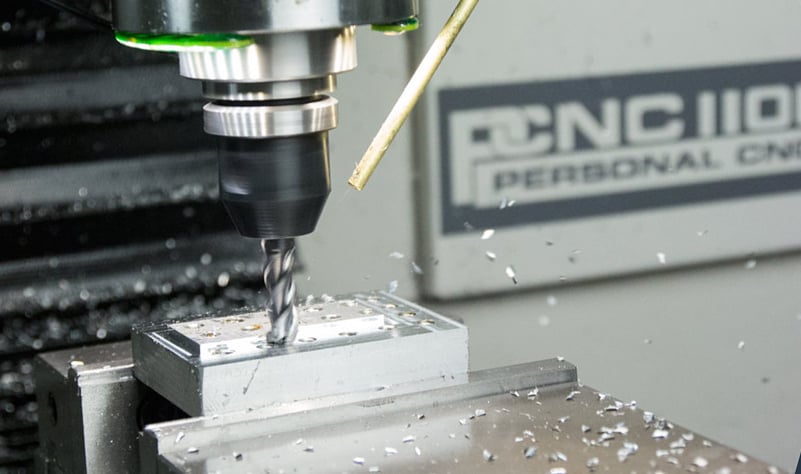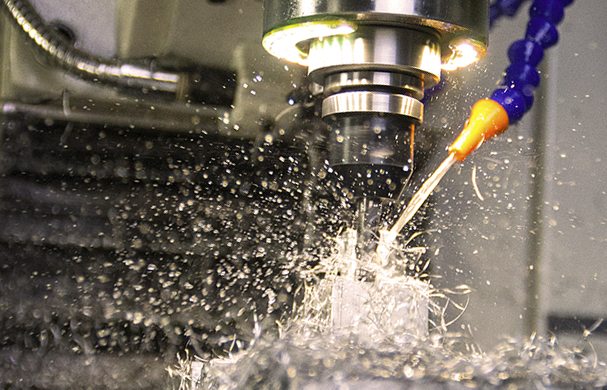Selecting the right coolant for the job may seem straight forward, but there had to be a reason there are so many options, so I started digging around. Here’s what I learned:
Coolant Doesn’t Just Cool
The first thing I learned was that coolant isn’t as straightforward as it may seem. For many applications, cooling isn’t even the main purpose of the system. Most of the time, it’s used to clear chips and add some lubricity, and sometimes it’s also used to keep the tool cool.
Flood coolant is great at pushing chips out of the way, delivering lubricant to the cutting tool, and getting your tool sopping wet. It’s also going to be a huge mess.

Mist coolant also is also great at blasting the chips out of the way with an air blast. The lubrication is delivered through the air, and it provides minimal cooling since there isn’t much water or fluid.
Air blast is also still a type of coolant, just without the fluid and oil.

Not All Coolants Are the Same
Then, you need to figure out what to put in the system. There is a spectrum of lubricants which run from fully synthetic to straight oil.
Full synthetics are mixed with water, compared to straight oil which isn’t combined with anything.
How to Pick the Right System
Choosing these systems things relies on two factors – your cutting tool and what you’re cutting.
Cutting Tools: We’re just going to focus on high speed steel (HSS) and carbide cutting tools for now, even though there are diamond cutting tools and others available. Carbide tools can get hot, but these cutters are susceptible to thermal shocking. That means we’re going to want to go light on coolant or we might shatter our tool. High speed steel is more flexible, but it also can’t get hot, so you’ll want a constant stream of flood coolant. If you don’t, your tool will wear down quickly and eventually weld itself into the part.
Materials: The material you’re machining is just as important to consider. Aluminum is notorious for its forgiving but sticky surfaces, so you’ll want an oil with lots of lubricity to keep chips from sticking to the tool. That’s why you’ll want a coolant with a high oil content, such as a straight oil.
Steel on the other hand, are harder but not sticky, so they generate more heat when they’re being cut. If you don’t get these mounds of chips away from the cutting tool, things are going to heat up even more since you’ll end up re-cutting chips. That’s why you want to air blast coolant without fluid or oil. For stainless steel, you’ll want to use a coolant with a high oil content, like straight oil, since it has the stickiness associated with aluminum, but with the hardness of steel.
Cutting Scenarios
So, lets combine all these factors.
Let’s say I’m machining an aluminum part with a HSS cutting tool. I should choose a synthetic flood coolant, since the fluid will keep the heat-sensitive cutting tool cool, blast away chips with the fluid, and provide a steady stream of lubricant.
What if I’m cutting the same part but with a carbide tool? We’re going to want to go a completely different route, and choose an air blast mist with a high oil content. Remember, we still want to push those sticky chips away from the tool, but if we avoid using flood coolant, we don’t have a huge mess to clean up. We’re not too worried about thermal shocking with aluminum, but if this was an alloy steel, then that would be a concern.

Now, what if I’m deep pocketing a part with a carbide tool? We already said before I need to flush those chips out, but an air blast won’t be enough to get the chips out of the pocket. Here’s your solution: run the roughing operations as we talked about with a mist coolant, and just before pocketing starts, you switch to a flood coolant. When you’re done, and move to more roughing or finishing, you switch back.
General Coolant Tips:
- Choose a coolant appropriate to your part, cutting tool, and coolant delivery system.
- Always have a steady flood of coolant when you’re tapping, whether it’s on the lathe or mill, since these tools fit tightly into the work piece and can easily snap
- Remember to check your coolant concentration for optimal machine performance and to prevent rust.
Do you have any coolant tricks that work great for you? If so, it would be great to hear about them. Comment below or email them to us.


